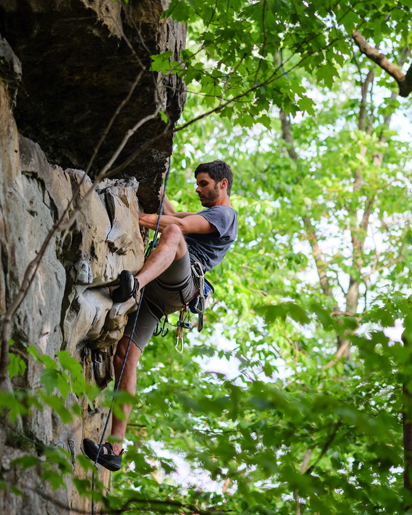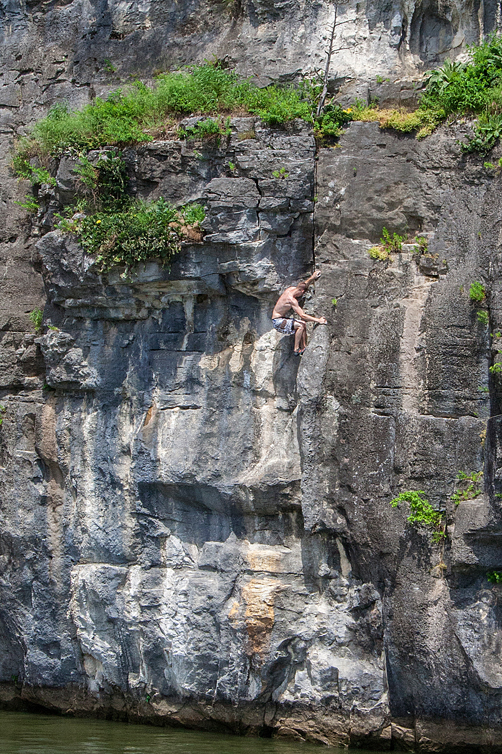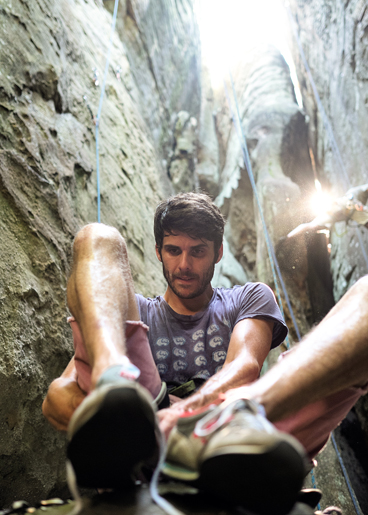
Baton Rouge climbing groups hit the road
Local climber Paul Knox says he was scared the first time he climbed in the mountains. “It was way taller than anything I had climbed. It’s kind of shocking,” he says.
Weekends send climbing enthusiasts on road trips to out-of-state rock climbing destinations
By Jonathan Olivier • Photos by Stephen R. Barnes
It’s Friday in Baton Rouge. To a group of local rock-climbers, that usually means the start of a weekend road trip focused solely on climbing.
“We camp, wake up and eat, and then go climb literally all day,” Paul Knox, a local climber, says. “We climb until we are super-tired then go back to camp and eat food and hang out. Then we go to sleep and do it again.”
|
|
For a typical group of rock-climbers, Knox’s weekend summation is pretty normal. But south Louisiana climbers are anything but typical.
There aren’t any rock formations to climb outdoors near Baton Rouge—or even in Louisiana, for that matter. So climbers here build their skills by practicing indoors at one of the three gyms with climbing facilities in Slidell, Lafayette and New Orleans, or in Baton Rouge at a rock tower maintained by BREC. Another small climbing gym, located in the LSU University Recreation Complex (UREC), closed in December 2014 for renovations and will reopen in 2016.
When climbers want to put the skills they’ve gained indoors to the test, they hit the road in search of real rock faces to scale.

“There probably aren’t other people willing to drive eight hours to climb for two days,” Knox says. “But when you live in Baton Rouge and (traveling) is the only opportunity, you’ll take any opportunity to go climb.”
Sometimes that means driving all day Friday, climbing on Saturday and driving back on Sunday.
But the long drive is worth it to spend even a day away from the flat swamplands in a place where you can put hand to rock. The experience couldn’t be more different than climbing indoors, Knox says.
“I was really scared when I went outside the first time,” he says. “It was way taller than anything I had climbed. It’s kind of shocking.”
The climbing-addicted groups of up to 30 locals that set out on these trips range from pre-teens to adults pushing 50. They roll out to destinations like Alabama, Tennessee or Texas for barely two days of climbing, and come Sunday, it’s back home to get ready for school or the daily 9-to-5.
It may seem like a lot of work, but it’s the price a Louisiana climber is willing to pay. And living so far away from a long-established climbing culture—the kind you’d find in recreation-heavy mountainous regions—affects more than just how far one has to travel to climb.
“There’s a lot more beginner access in places like Colorado or Chattanooga, (Tennessee),” says Lee Guilbeau, a local climbing instructor with more than a decade of experience. “There’s a bigger gap if you’re starting here indoors without really any relevance or context to outdoors. You have to research more as a beginner—really go for it and have more of a drive.”
Guilbeau attempts to narrow that gap in Baton Rouge. He picked up an affinity for the sport while at LSU, and it only grew when he lived in Colorado for a spell. Since he’s been back in Louisiana, promoting the climbing culture and climbing safety have been top priorities. He’s shared his experiences through teaching classes for BREC and traveling on the weekends with other climbers.
A lot of the climbers in Baton Rouge are in their 20s, and many got into the sport in college as an extracurricular activity. They may have heard about it through a friend or got interested when they walked past the rock wall in the UREC. Outside a few small circles, the sport has largely been something of a counterculture.
“It was weird when I started to climb in Louisiana,” says Knox, who began climbing after he graduated from LSU. “I had never even considered the idea of rock-climbing, never thought about it or seen a video of rock-climbing. I’d imagine it’s probably not that strange in most of the country.”

Knox and Guilbeau are something of exceptions among the local climbing community, though. They both are afflicted with the climbing bug, yet still call Baton Rouge home. In many cases, when climbers graduate from LSU or just get heavily involved with the sport, they leave and take their love for climbing with them. For some, climbing is the sole reason why they leave Louisiana.
“A lot of people leave as soon as they finish LSU and keep climbing because they can’t take it anymore, being so far away from rocks,” Guilbeau says.
Still, south Louisiana, an area historically devoid of a sizable climber culture, is seeing a surge in new participants.
Baton Rouge climber Doug Smith started climbing around the same time as Guilbeau in 2000. Smith and Guilbeau are two of the older climbers in their group. During Smith’s college days, he’d drive to the Lafayette gym, Rok Haus, to climb. The sport had a small following then, Smith says. He moved away in 2013 and came back a year later to find the climbing scene changed.
“I was flabbergasted by the amount of growth in climbing when I came back,” Smith says. “There’s a lot more people.”
The growth is due to efforts by those like Guilbeau, who was pivotal in starting the Louisiana Rock Climbing Series, a climbing competition that began in 2013. The competition, which spans the state’s three gyms, is the first of its kind, a testament to the growing climbing demographic.

The newest climbing gym in south Louisiana, the New Orleans Boulder Lounge, opened in July 2015. Once the UREC expansion is completed sometime in 2016, it’ll house a rock wall and larger bouldering area. But there’s also been talk by Guilbeau and others to open a large, privately owned gym in Baton Rouge.
Some climbers who don’t feel like traveling to a gym simply build rock walls in their homes. Guilbeau converted his garage into a small climbing facility.
Perhaps most important to keeping the Louisiana climbing culture growing into the future, a handful of new climbers are starting young.
Take 14-year-old climber Angus Armstrong, for instance, who looks up to Guilbeau and others as mentors. Armstrong, who has been climbing for about three years, got his start at the BREC tower under Guilbeau’s guidance and has since grown into one of the best young climbers in the region.
Central to the climbing culture is the unique sense of family and hospitality. It’s one of the reasons Armstrong has been able to become so engrossed in the sport.
“They feel like brothers and fathers to me,” Armstrong says about his peers. “They are the best teachers and friends I have. They are amazing and always have my back.”
The same sense of belonging Armstrong feels is common among the older climbers, too. It’s resonated across the group.
“I’ve become good friends with the people I climb with now,” Knox says. “You put your life in their hands, and on some level, that creates a bond.”
The tight-knit community makes it easy for newbies to get involved, too. Guilbeau says those interested in getting into climbing just need to show up at the BREC rock wall, talk to a few veteran climbers and start learning how to work their way up the wall.
For its vertical shortcomings alone, Louisiana will likely never be a hub for climbing like those that exist in Colorado or in California’s Yosemite Valley. But that won’t stop those with a love for the lifestyle from climbing here. If anything, being a climber in Louisiana only fuels the desire to get into the mountains and climb.
Where to climb
Climbing facilities in Baton Rouge and nearby:
• Perkins Road Community Park, brec.org/perkins
• Rok Haus in Lafayette, rokhaus.com
• Slidell Rocks, slidellrocks.com
• New Orleans Boulder Lounge, climbnobl.com
Roadtrip-worthy:
These are just a few of the spots Baton Rouge climbers visit on their weekend road trips—there are many more within driving distance.
Destination Estimated Drive Time
1. Cherokee Rock Village, near Leesburg, Alabama, 7 hours
2. Foster Falls Small Wild Area, near Chattanooga, Tennessee, 8 hours
3. Milton Reimers Ranch Park, near Austin, Texas, 7 hours
4. Horseshoe Canyon Ranch, near Jasper, Arkansas, 9 hours
Editor’s note: This story has been updated since its original publication.
|
|
|

